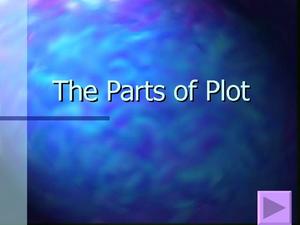All-in-One High School
Elements of Plot
Cinderella wants to go to the ball and marry the prince. At the end of the story, she does! But how does the plot move from the exposition to the resolution? Teach language arts learners and fairy tale fans about the basics of plot...
Soft Schools
Plot — 3rd or 4th Grade
After reading a version of "The Tortoise and the Hare," scholars complete a plot diagram. They pinpoint the tale's beginning, rising action, climax, falling action, and ending.
Texas Education Agency (TEA)
Isolated Scenes and Plot Support (English II Reading)
And the plot thickens! The third interactive in this series introduces young scholars to the cause-and-effect nature of a fictional story plot. They learn about the characteristics of exposition, rising action, climax, falling action,...
Curated OER
Parts of the Plot: Constructing A Plot Diagram
After reading "The King of Mazy May" by Jack London, learners reinforce their literary analysis skills in this SMART board lesson. The provided SMART board file allows themto define elements of a short story, and then add it to the plot...
Curated OER
Parts of the Plot: Constructing a Plot Diagram
Sixth graders conduct a plot diagram for a short story. They identify the problem, the rising action, the climax, the falling action, and the resolution. Students are able to sequence events in a story, and identify the parts of the plot...
PB Works
The Cay by Theodore Taylor
Record the plot elements of The Cay on this worksheet. Pupils note basic information about the book and answer questions about the introduction, point of view, character, conflict, rising action, climax, falling action, and resolution of...
Curated OER
Story Plot Graph
This graphic organizer allows readers to visualize the introduction, rising action, climax, falling action, and denouement of a story by filling in five corresponding boxes with details from a story.
Curated OER
Five Elements of a Story
Here’s a graphic organizer that permits learners to chart the introduction, rising action, climax, falling action and resolution of a story. The PDF file can be customized to work with any narrataive.
Curated OER
Parts of Plot
Questions are given on each slide of this presentation, asking learners to identify parts of plot. The questions have two answers per slide for readers to choose between, multiple-choice style. The last two slides are labeled "Great Job"...
Curated OER
Story Plot Terms
This literary terms handout defines introduction, rising action, climax, falling action, and denouement.
Curated OER
Plot of a Short Story (SMART Board)
Help your pupils track the plot of a short story with this SMART Board activity. Using the short story "The Dinner Party" by Mona Gardner (though the lesson plan would work with any other short story), they define the exposition, rising...
Curated OER
Using Plot Elements to Retell a Story
The stories in Sandra Cisneros’s The House on Mango Street form the basis for a lesson plan on plot elements. The class examines introduction, sequence, problem, rising action, climax, falling action and resolution and identifies these...
Curated OER
Plot Structure PowerPoint Presentation
A plot diagram helps readers visualize the structure of a story. Here’s a presentation that expands upon the traditional diagram and examines plot components (exposition, rising action, climax, falling action, resolution) as well as...
Curated OER
Around the Room Short Story
Collective story writing is a great way to reinforce the concept of story elements and collaborative learning. Young writers discuss story elements such as, setting, character, action, climax, conclusion, foreshadowing, dialogue, and...
Curated OER
Plot and Conflict in W.W. Jacob's "The Monkey's Paw"
Tenth graders analyze the use of literary elements in W.W. Jacob's "The Monkey's Paw." Literary analysis is accomplished by a review of the plot and order of events in the story. Learners work in pairs to match the events from the story...
Curated OER
Making Predictions about the Climax
Fourth graders read the passage titled Hide and Seek and predict what will happen in the climax of the story by using the rising action. In this climax lesson plan, 4th graders use a worksheet provided to them.
Curated OER
Plot Structure
Ninth graders review the parts of a plot sequence for a short story. They think of a famous Disney movie and plot the events of the movie in the correct plot sequence. They do the same for a comic strip, labeling the exposition, rising...
Curated OER
Plot Summaries
In this plot summaries activity, students read the plot summaries and write what the expositions, inciting moments, rising actions, climaxes, falling actions, and denouements are in them. Students do this for 2 plot summaries.
Curated OER
Academic Vocabulary
Arm your writers with an arsenal of literary terms. With definitions of everything from plot structure and figurative language to point-of-view and types of irony, learners will gain an understanding of elements in stories and be able to...
Curated OER
Plot Structure Graphic Organizer
In this plot structure graphic organizer worksheet, learners record the plot structure of a story. They record the introduction, rising action, climax, falling action, and the resolution.
Shmoop
ELA.CCSS.ELA-Literacy.RL.9-10.5
Your students already know when they like a story and when they don't, but they may not know that the plots of these stories are shaping that opinion. Like all resources in this series, the two activities and quizzes provided here deal...
Curated OER
Illustrating the Elements of a Story
Explore the elements of a story with this two-page graphic organizer. Readers write and draw descriptions of each element, including setting, plot, conflict, rising action, climax, dialogue, and narration.
Curated OER
Literature: Plot Patterns
Students read and analyze "An Occurrence at Owl Creek Bridge" for plot patterns. In a plot summary pyramid, they organize the story elements in sequential order. To illustrate plot summary techniques, students cite examples from...
Curated OER
An Occurrence at Owl Creek Bridge Lesson Plan 5
Students continue to read the story "An Occurrence at Owl Creek". In groups, they define the word foreshadowing. They identify the points in the story that they believe are the rising action, climax, falling action and resolution. They...

























